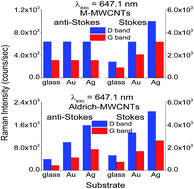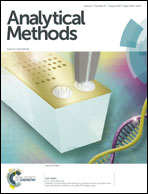Anti-Stokes Raman spectroscopy as a method to identify metallic and mixed metallic/semiconducting configurations of multi-walled carbon nanotubes
Abstract
SERS studies were performed on films of two families of multi-wall carbon nanotubes (MWCNTs) under an excitation light of 514.5 nm and 647.1 nm. These included Aldrich-MWCNTs, which alternate semiconducting and metallic tubes and M-MWCNTs that contain only metallic tubes obtained by water assisted catalytic chemical vapour deposition (CCVD). The two families of MWCNTs reveal similar spectra in the Stokes branch, which feature an increasing Raman intensity when the glass substrate is replaced with an Au or Ag substrate, indicating a (surface enhanced Raman scattering) SERS mechanism. In the anti-Stokes branch, despite an enhancement of approximately 100 times compared to the predictions of the Boltzmann law, only Aldrich-MWCNTs exhibit a Raman spectrum with an intensity that increases as a result of the change in the glass substrate to Au or Ag, a fact that is revealed by the signature of the SERS process. The invariance of the Raman intensity in the anti-Stokes branch as a result of the change of the substrate is characteristic of M-MWCNTs and results from a Raman light scattering process that takes place only within the skin depth of the metallic structure.


 Please wait while we load your content...
Please wait while we load your content...